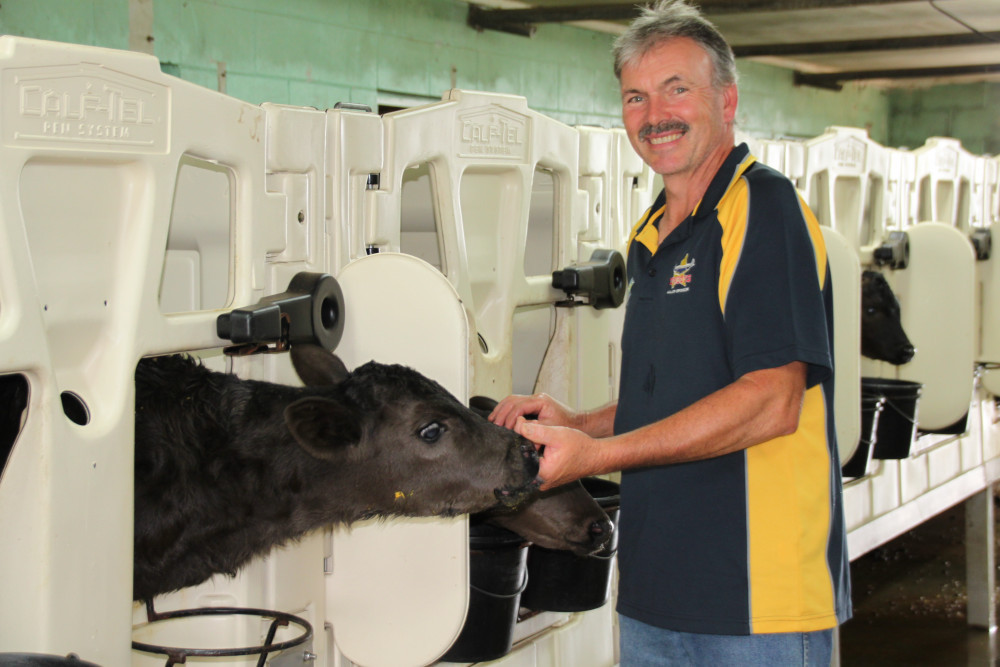On The Land
14 November, 2021
Farmers take genetic control
ATHERTON Tablelands dairy farmers are taking genetic control over their herds’ reproductive performance in a bid to maximise production and control breeding outcomes.

Charlie and Elizabeth Maier and Colin and Shelley Daley from the Millaa Millaa area have been at the forefront of this scientific revolution, using both pre-sexed semen and beef genetics in their operations.
Charlie and Elizabeth moved to the Tablelands from their family farm in Reichenbach, Germany in 2001 and bought a dairy block in the Malaan area, outside Millaa.
Continuing with practices established in Germany, they never owned a bull, impregnating every cow by artificial insemination (AI).
“In 2004, we decided we didn’t want the age old problem of surplus dairy bull calves, so we began inseminating the balance of our milkers with Wagyu semen to open up a new market opportunity for our business,” Mr Maier said.
The buyer, who was an Innisfail banana grower, was picking up the calves at a few days of age, growing them to a target weight and exporting them to Japan.
The Wagyu market has waxed and waned over the years and the Maiers have experimented with Angus/Brangus semen and raising those beef calves to weaner age, but recently returned to Wagyu when a new market for them opened locally.
“We buy Wagyu semen from Jason Bubb at Malanda and he buys the calves back from us at around four weeks of age and 80-120kg for around $4.30 a kilogram. They are then sent down to a feedlot at Tamworth,” Mr Maier said.
“We work out how many replacement females we need to breed each year to maintain our 240 head milking herd, allowing a margin for the slightly reduced conception rate of sexed semen. We start inseminating when the temperatures cool off in April and have usually reached our quota by September.”
Earlier on there were issues with sexed semen that made it unattractive to many farmers. Conception rates were around 10 per cent lower than could be expected with normal semen and there was quite a limited gene pool to choose semen from, but both these problems have reduced over time.
Cost remains the most prohibitive factor. Sexed semen can cost up to double that of normal semen, but to date, the management benefits delivered more than off set the extra expense for these farmers.
“We are able to choose the best of our milkers to breed replacement heifers from, strengthening the quality and performance of our whole herd and the cheaper beef semen used on our lower production cows balances out the overall cost,” Mr Maier said.
More recently, Colin and Shelley Daley, of Ourway Holsteins at Millaa Millaa, have gone one step further with their breeding program.
Already committed to the combined use of sexed dairy semen and a beef AI program with the remaining 30 per cent of their herd, they have now branched into the genomic testing of their heifers.
Genomics are the study of the entirety of an organism's genes, called the genome. Using high-performance computing and math techniques, genomics researchers analyse enormous amounts of DNA-sequence data to find variations that affect health, disease or drug response.
“By simply pulling a few tail hairs or taking a little notch out of the ear of a two-day bull calf, the University of Queensland team of scientists can tell us the level of mastitis resistance, the approximate milk production capability and length of the productive life of his daughters,” Mr Daley said.
“I certainly had my doubts about the accuracy of the results of these tests when we started testing a small group of the herd a few years ago, but those animals have now come through the system and are living up to all their genomic predictions,” he said.
Not only are the predicted types emerging true to form, but genomics gives producers the ability to manipulate many areas of reproductive performance. Purchasers can choose semen based on the presence of characteristics such as ability to convert feed into milk, polledness, udder, feet and leg confirmation and genetic disorders like the tendency to abort.
“I believe the cost of up to $50 per head will be outweighed by the benefits that emerge. Our increased knowledge of our herd will allow us to build more effective herd reproductive management plans,” Mr Daley said.
“We sell a few Ourway bulls each year, which under new Holstein Australia rules, must be genomically tested. We are all using good genetics now and in some cases, testing can pick up an outstanding home-bred sire that could go on to be a real herd improver at a state or international level.
“I believe we will test most of our youngsters going forward. We will keep selecting our best younger or more consistent breeders for insemination with sexed semen and want to keep creating a very saleable item with our beef calves, growing them out to the 100kg mark,” he said.
Colin said he wanted to address early indications there was room for improvement in his herds' feed conversion rate results and wanted to closely examine their Heat Tolerance Australian Breed Values.
It’s not a path Colin and Shelley ever envisaged their business taking, but with children interested in continuing in the dairy industry and with Australian scientists leading the world in this area of science, Mr Daley believed it made sense to use the tools available to hasten the development of their family business.



